- Clone
- M1/69 (See other available formats)
- Regulatory Status
- RUO
- Other Names
- Heat Stable Antigen (HSA), Ly-52, Nectadrin
- Isotype
- Rat IgG2b, κ
- Ave. Rating
- Submit a Review
- Product Citations
- 44 publications
| Cat # | Size | Price | Quantity Check Availability | Save | ||
|---|---|---|---|---|---|---|
| 101813 | 25 µg | $94 | ||||
| 101814 | 100 µg | $268 | ||||
CD24 is a 35-45 kD protein also known as Heat Stable Antigen (HSA), Ly-52, or Nectadrin. It is a GPI-linked sialoglycoprotein expressed on lymphocytes, granulocytes, epithelial cells, thymocytes, monocytes, erythrocytes, and dendritic cells. CD24 expression varies during T and B cell differentiation and is a useful marker for delineating various lymphocyte developmental stages. CD24 serves as an adhesion or costimulatory molecule involved in T and B lymphocyte activation and differentiation by homophilic binding or binding to CD62P.
Product DetailsProduct Details
- Verified Reactivity
- Mouse
- Antibody Type
- Monoclonal
- Host Species
- Rat
- Immunogen
- C57BL/10 mouse splenic T cells and concanavalin A-activated splenocytes
- Formulation
- Phosphate-buffered solution, pH 7.2, containing 0.09% sodium azide.
- Preparation
- The antibody was purified by affinity chromatography, and conjugated with APC under optimal conditions.
- Concentration
- 0.2 mg/ml
- Storage & Handling
- The antibody solution should be stored undiluted between 2°C and 8°C, and protected from prolonged exposure to light. Do not freeze.
- Application
-
FC - Quality tested
- Recommended Usage
-
Each lot of this antibody is quality control tested by immunofluorescent staining with flow cytometric analysis. For flow cytometric staining, the suggested use of this reagent is ≤0.06 µg per million cells in 100 µl volume. It is recommended that the reagent be titrated for optimal performance for each application.
- Excitation Laser
-
Red Laser (633 nm)
- Application Notes
-
Additional reported applications (for the relevant formats) include: Western blotting1, in vitro induction of thymocyte maturation2, complement-mediated cytotoxicity3, and immunohistochemistry of acetone-fixed frozen sections4, formalin-fixed paraffin-embedded sections5 and zinc-fixed paraffin-embedded sections10. The Ultra-LEAF™ purified antibody (Endotoxin < 0.01 EU/µg, Azide-Free, 0.2 µm filtered) is recommended for functional assays (Cat. No. 101845 and 101846).
-
Application References
(PubMed link indicates BioLegend citation) -
- Springer T, et al. 1978. Eur. J. Immunol. 8:539. (WB)
- Crowley M, et al. 1989. Cell. Immunol. 118:108. (FA)
- Veillette A, et al. 1989. J. Exp. Med. 170:1671. (FA)
- Pandelakis A Flavell RA 1999 JEM 189:855 (FC, IHC)
- Liu JQ, et al. 2007 J. Immunol. 178:6227. (FC, IF)
- Chappaz S, et al. 2007. Blood doi:10.1182/blood-2007-02-074245. (FC) PubMed
- Rucci F, et al. 2010. Proc Natl Acad Sci USA. 107:3024. (FC) PubMed
- Teague TK, et al. 2010. Int Immunol. 22:387. (FC) PubMed
- Gracz AD, et al. 2010. Am J. Physiol Gastrointest Liver Physiol. 298:590. (FC) PubMed
- Chen CY, et al. 2008. Endocrinology. 10:1210. (FC, IHC) PubMed
- Qui Q, et al. 2010. J. Immunol. 184:1681. (FC) PubMed
- Product Citations
-
- RRID
-
AB_439715 (BioLegend Cat. No. 101813)
AB_439716 (BioLegend Cat. No. 101814)
Antigen Details
- Structure
- GPI-linked sialoglycoprotein, 35-45 kD
- Distribution
-
B cells, granulyocytes, epithelial cells, thymocytes, monocytes, erythrocytes, dendritic cells
- Function
- Regulates B cell proliferation and differentiation
- Ligand/Receptor
- P-selectin, CD24
- Cell Type
- B cells, Dendritic cells, Epithelial cells, Erythrocytes, Granulocytes, Monocytes, Thymocytes
- Biology Area
- Immunology
- Molecular Family
- CD Molecules
- Antigen References
-
1. Barclay A, et al. 1997. The Leukocyte Antigen FactsBook Academic Press.
2. Aigner S, et al. 1997. Blood 89:3385.
3. Hough MR, et al. 1996. J. Immunol. 156:479.
4. Liu Y, et al. 1992. J. Exp. Med. 175:437. - Gene ID
- 12484 View all products for this Gene ID
- UniProt
- View information about CD24 on UniProt.org
Related FAQs
Other Formats
View All CD24 Reagents Request Custom ConjugationCustomers Also Purchased
Compare Data Across All Formats
This data display is provided for general comparisons between formats.
Your actual data may vary due to variations in samples, target cells, instruments and their settings, staining conditions, and other factors.
If you need assistance with selecting the best format contact our expert technical support team.
-
Biotin anti-mouse CD24
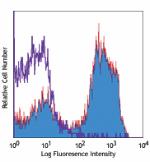
C57BL/6 splenocytes stained with biotinylated M1/69, followe... -
FITC anti-mouse CD24
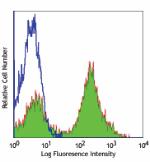
C57BL/6 mouse splenocytes stained with M1/69 FITC -
PE anti-mouse CD24
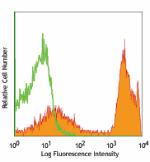
C57BL/6 mouse splenocytes stained with M1/69 PE -
Purified anti-mouse CD24
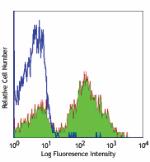
C57BL/6 mouse splenocytes stained with purified M1/69, follo... -
Brilliant Violet 510™ anti-mouse CD24
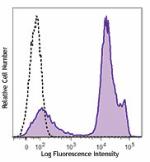
C57BL/6 splenocytes were stained with CD24 (clone M1/69) Bri... -
PE/Cyanine5 anti-mouse CD24
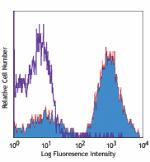
C57BL/6 mouse splenocytes stained with M1/69 PE/Cyanine5 -
APC anti-mouse CD24
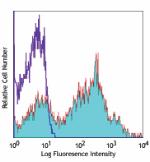
C57BL/6 mouse splenocytes stained with M1/69 APC -
Alexa Fluor® 488 anti-mouse CD24
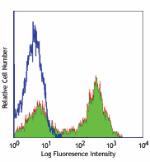
C57BL/6 mouse splenocytes stained with M1/69 Alexa Fluor®... -
Alexa Fluor® 647 anti-mouse CD24
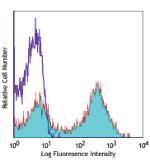
C57BL/6 mouse splenocytes stained with M1/69 Alexa Fluor®... -
Pacific Blue™ anti-mouse CD24
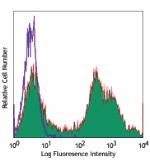
C57BL/6 mouse splenocytes stained with M1/69 Pacific Blue&tr... -
PE/Cyanine7 anti-mouse CD24

C57BL/6 mouse splenocytes stained with M1/69 PE/Cyanine7 -
Alexa Fluor® 594 anti-mouse CD24

C57BL/6 mouse frozen spleen section was fixed with 4% parafo... -
PerCP/Cyanine5.5 anti-mouse CD24
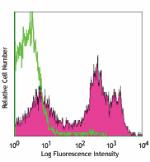
C57 splenocytes stained with M1/69 PerCP/Cyanine5.5 -
Brilliant Violet 421™ anti-mouse CD24

C57BL/6 splenocytes were stained with CD24 (clone M1/69) Bri... -
Brilliant Violet 605™ anti-mouse CD24
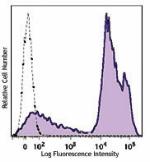
C57BL/6 splenocytes were stained with CD24 (clone M1/69) Bri... -
Purified anti-mouse CD24 (Maxpar® Ready)
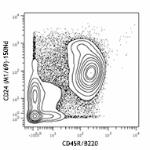
C57BL/6 mouse splenocytes stained with 176Yb-anti-CD45R/B220... -
PE/Dazzle™ 594 anti-mouse CD24
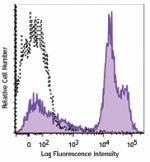
C57BL/6 splenocytes were stained with CD24 (clone M1/69) PE/... -
Alexa Fluor® 700 anti-mouse CD24

C57BL/6 splenocytes were stained with CD24 (clone M1/69) Ale... -
APC/Fire™ 750 anti-mouse CD24
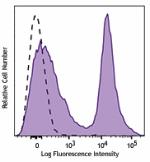
C57BL/6 mouse splenocytes were stained with CD24 (clone M1/6... -
TotalSeq™-A0212 anti-mouse CD24
-
TotalSeq™-C0212 anti-mouse CD24
-
TotalSeq™-B0212 anti-mouse CD24
-
Ultra-LEAF™ Purified anti-mouse CD24
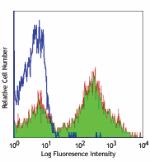
C57BL/6 mouse splenocytes stained with Ultra-LEAF™ purified ... -
APC/Cyanine7 anti-mouse CD24 Antibody

C57BL/6 splenocytes were stained with CD19 FITC and anti-mou... -
Brilliant Violet 711™ anti-mouse CD24

C57BL/6 splenocytes were stained with anti-mouse CD19 FITC a...

 Login/Register
Login/Register 












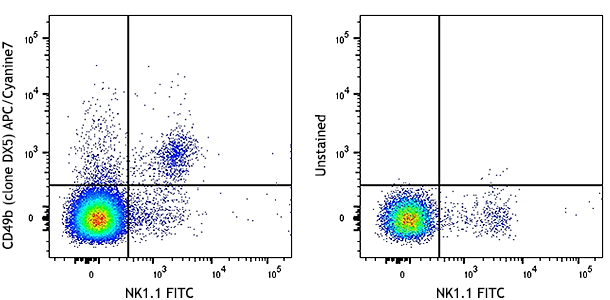
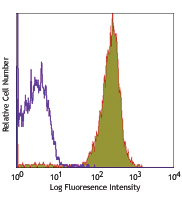

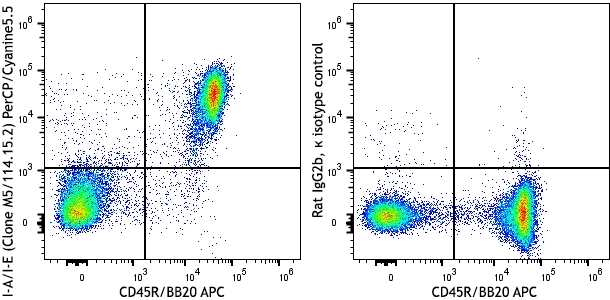







Follow Us